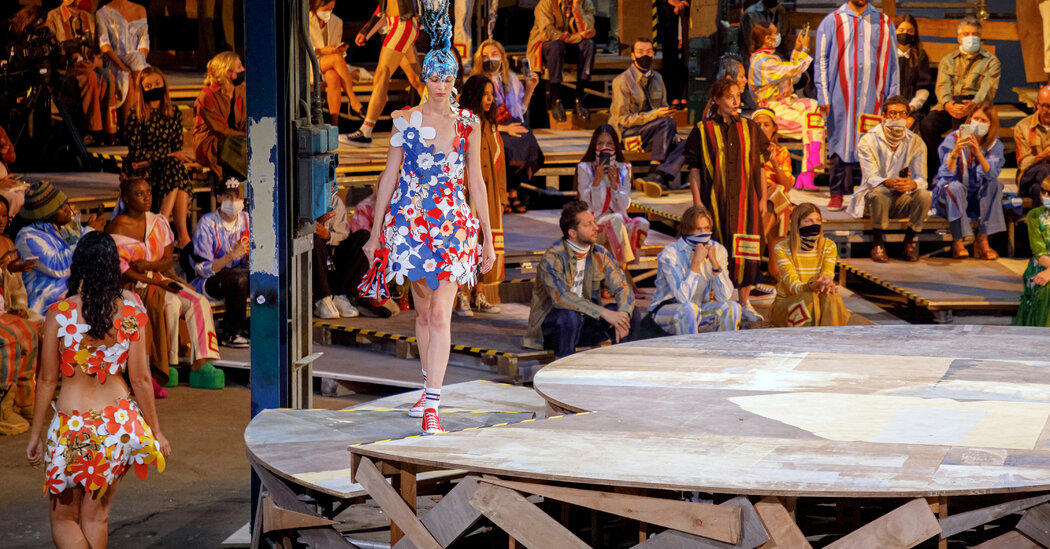
From the start, it was clear that this Marni show was not going to be like the other ones. Every guest was asked to wear a sort of Marni uniform — an upcycled garment from a former collection that the designer Francesco Risso and his team had hand-painted with sweeping washes of stripes — and to stop by the Marni headquarters first for a fitting. Whether they were the sort of person who generally felt drawn to the magpie, haute art-school aesthetic that Mr. Risso has brought to the house — or not.
I was given a navy dress with a big portrait neckline made of some taffeta/nylon material that swished when I moved, and splotched with chartreuse stripes. The paint and the fabric made it a little stiff, so it had a tendency to move on its own. When I tried it on in the studio, I felt relatively ambivalent: As a critic, I thought it was pretty and interesting; as a wearer, I felt like I was faking it and thus kind of resentful about putting it on in the first place.
But when I arrived at the show on Saturday night, staged like a theater in the round, and there were stripes, stripes, everywhere you turned — in oversize shirts and trousers and jackets and skirts, each one with a white canvas patch framed in red reading “Marniphernalia: Miscellaneous Handpainted Treasures” and numbered (mine was 300/800)— I started to feel something different.
Then a conductor walked to center stage. A Marni-clad chorus seeded themselves throughout the space and began to hum a song composed for the show by Dev Hynes, the musical multi-hyphenate, called “Guide You Home.” Models of all shapes and sizes and genders and ideas of beauty spiraled down from the top row of the arena, wearing shredded Aran knits and striped dresses ribboned around the body, looking like cans of paint had been tipped over their hair. The rapper Mykki Blanco emerged from the wings, reciting some sort of spoken word something that included the phrase “I am the primal ejaculation of the mountains.”
A horde of fashion students who had been invited to attend emerged from the audience in the stripy upcycled clothes and started to ooze in and out and around like they were being tugged by invisible strings. The singer Zsela, in a sky blue daisy bra and long daisy-chain skirt, took to the stage and sang. More models appeared, in stripes and knits and daisy prints and daisy appliqués. Mr. Risso, the brand’s creative director, was among them, wearing a giant yellow and blue striped knit scarf draped over his shoulders and dragging to the floor, and yellow- and white-stripe pants. He did his walk and then sat in the front row to watch the ebb and flow of the show. At the end, there was a lot of hugging.
Half the time I felt like I was in an ersatz fashion version of the musical “Hair.” Half the time I thought I was in some Wes Anderson po-faced sendup of happenings and performance art. Most of the time I wasn’t sure exactly what was going on and which part anyone was supposed to be playing. Sometimes, I just wanted to put down my pen, scratch my head and laugh.
It was ridiculous, kind of charming and wholly devoid of irony. Also a subtly pointed riposte to those who would say the clothes looked weird on the runway, since so much of the audience seemed at ease in their gear. And entirely impossible to escape the sensation that, like it or not, you had just been part of something.
It could have gone badly wrong; fallen into the category of overblown spectacle like the Moncler MondoGenius “global event,” spanning Milan to Shanghai and hosted by Alicia Keys (in Milan) and Victoria Song (in Shanghai) intoning lines like “What is truth?” while accompanied by meaningful pauses and videos created by the brand’s 11 collaborators, including J.W. Anderson, DingYun Zhang and Gentle Monster, to showcase their puffer artistry.
It would have been easy to play it quiet and intimate, like Giorgio Armani with his sunset-by-the-Med collection of liquid seaside suiting and nymphaes tulle gowns.
Or keep to the old rules of the basic runway like Salvatore Ferragamo (and, indeed, most designers thus far this season) — though even the basic runway is not without its risks, since it makes clunkers hard to hide. Like, for example, the entirely misguided idea that any grown woman might want to wear a diaper dress. Ever. Ferragamo has been without a women’s wear designer since Paul Andrew left in April, and it shows.
Instead, Marni’s Mr. Risso did something else: He took the idea of performance and only-in-person experience, which began in New York with designers like Rachel Comey and Thom Browne, and smashed the fourth wall between audience and show — not just to pay lip service to the idea of community or to produce a polished sartorial meditation on the idea of the uniform, but to take “inclusivity” to its natural conclusion and remind everyone that getting dressed is a universal imperative.
That meant, whether or not you ever actually wanted to wear your outfit again (or whether, like me, you had to give it back as per The New York Times ethics policy), it had meaning. Which is, and always should be, the point.






